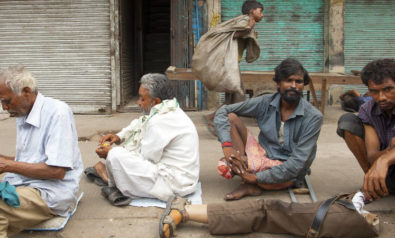Ukraine has many willing and able experts in designing and implementing a meaningful health care reform package. The time for change is now.
On December 25, 2015, as many people across the world were waking up to the gifts under the tree, Ukraine woke up to its parliament’s newly approved budget for 2016, aimed at reducing the general government deficit—a key condition to secure financial aid from International Monetary Fund (IMF).
With reductions across the board, the new budget made it clear that 2016 was going to be yet another year of tightening belts in all sectors, including public health care. The new budget allocated only $2.3 billion to the Ministry of Health, which is $81.5 million less than in 2015. This means the new budget can only meet about 30-40% of the country’s needs for public health care. Government assistance for individuals suffering from AIDS, cancer, cardiovascular diseases and hemophilia took the biggest hit.
The situation is alarming as these diseases are the leading causes of death in Ukraine. “Next year only 9.4% of people with hepatitis will survive,” says Olga Stefanishina, executive director of the charity foundation Patients of Ukraine, an association of patients lobbying pharmaceutical companies and the government for access to treatment in the country. HIV-bearers “lucked out,” Stefanishina sarcastically observes, as the Ministry of Finance will fund 24.8% of their needs; for individuals suffering from hemophilia, only 27.1% of required treatment will be provided.
A Cash Band-Aid?
Budget deficit undoubtedly puts Ukraine’s health care in dire straits, but at the same time, would more money solve all of its problems? As many health care experts have been claiming, it is not a shortage of money that has been eroding Ukraine’s health care system—it is how the cash is spent. Thus, Aleksey Shershnev, a head doctor and founder of the project Biotech: Rehabilitation of the Wounded, says that the main problem with Ukraine’s health care lies in poor “organization and optimization” of the infrastructure and “the value system of the doctors themselves.” Pavel Kovtonyuk, health care reform manager at Ukraine’s National Reform Council, adds that Ukraine’s Ministry of Health maintains “the second largest network of hospitals in Europe” by paying for unused hospital beds rather than providing care to patients who need it.
Indeed, in 2013, the World Health Organization (WHO) reported that there were approximately 879 beds per 100,000 people in Ukraine’s public sector—the second largest in Europe, after Belarus. Yet Ukraine’s health indicators are second worst in the region: Life expectancy in Ukraine is one of the lowest in Europe (on average, five-six years lower than in European Union countries); about 80% of deaths occur at a relatively young age, between 15 and 60; there is high prevalence of tobacco and alcohol dependency; and, worst of all, the existing health services fail to “prevent, detect, and treat diseases effectively,” according to Qimiao Fan, World Bank country director for Belarus, Moldova and Ukraine.
Why are Ukraine’s health indicators so low if its health care appropriations are some of the highest in Europe? One reason is that a staggering 75% of publicly-funded hospital beds are essentially unused, as they are located in small facilities and are typically in a dilapidated state. Not surprisingly then, overfunding of hospital services leaves little to nothing for primary health care, disease prevention, health promotion and life-saving medicines.
These systemic fund misappropriations in Ukraine’s health care are notorious, and calls for reform have been going on for quite some time. In January 2014, the need to coordinate reform efforts led to the creation of the Reanimation Package of Reforms (RPR), an organization that unites leading nongovernmental organizations (NGO) and experts in various fields, and serves as a coordination center for development and implementation of key reforms in Ukraine.
One of RPR’s leaders of health care reform is Oleksandr Yabchanka. Born and raised in Lviv, in western Ukraine, Oleksandr worked as a pediatrician for eight years before he followed a call of duty to join the Maidan uprising of 2014. Having survived the atrocities of the revolution and witnessed the death of many of his fellow activists, Yabchanka set out to continue the legacy of Maidan by joining the Reanimation Packet of Reforms, where he is leading medical reform.
Yabchanka is a go-to person for many other activists, including Roman Torgovitsky, the founder and CEO of Wounded Warrior Ukraine, an NGO dedicated to providing psychological rehabilitation training to Ukrainian veterans. Through his work, Torgovitsky encounters many systemic inadequacies of the health care system that is unable to accommodate the rising needs of returning soldiers. Torgovitsky’s experience fighting health care bureaucracy to help Ukraine’s veterans resonated with Yabchanka, who himself has no lack of insider insight into the broken system.
“Before I became a civil activist and a manager in Reanimation Package of Reforms, I worked as a pediatrician for eight years,” says Yabchanka. “Every evening, I would sit down with a pile of patient files and write ‘stable’ in each of them, one by one. All Ukrainian physicians do that. The patient may have been at home eating borsh for some time now, but the doctor is still lying about his or her ‘stable’ condition in the hospital. Why? Because if a doctor doesn’t maintain ‘proper’ records of the hospital’s occupancy, the hospital won’t meet the in-patient minimum to receive state funding. That is why rooms with empty beds and imaginary patients are heated all winter, and you, the taxpayers, are paying for this,” writes Yabchanka in an open letter on Facebook.
What’s to be Done?
Such stories, worthy of Nikolai Gogol himself, permeate the national debate on health care reform. Yabchanka and his team, in particular, have been advocating for more efficiency in hospital administration by providing hospitals with greater autonomy from—and lower dependency on—the central government. They call for a system that would convert hospitals into nonprofit purchasing agencies with substantial autonomy at the regional level to negotiate performance-based contracts with all providers—from primary health care to tertiary hospital level. More managerial power, if coupled with “effective mechanisms of supervision, evaluations of performance, and strategic decisions of health services development” could be “the most reasonable and efficient way for new facilities to operate,” says Paolo Belli, Head of the World Bank sector of Human Development in Ukraine, Belarus and Moldova.
Why are Ukraine’s health indicators so low if its health care appropriations are some of the highest in Europe? One reason is that a staggering 75% of publicly-funded hospital beds are essentially unused…
In this system, hospitals will be allowed to have their individual bank accounts (currently financed through central government channels), set tariffs for services provided, determine employee salaries, and make other budgetary decisions according to their specific needs. In addition, unused state money will not be lost; rather it will be invested in the hospital’s development. Besides, hospitals will be able to generate additional income by leasing their unused facilities to pharmacies, laboratories, kitchens and other services (until 2020, this additional income will be tax-exempt).
In other words, there has to be a shift from input-based funding (number of doctors, beds and patients determined by central planners) to output-based purchasing for more efficient use of government resources and more transparent hospital management system.
But not everyone is convinced that decentralizing health care management is the right choice for Ukraine, and the debate about the best reform model rages on. To help inform the public of the available choices, in the fall of 2015, Reanimation Package of Reforms experts Zoryana Chernenko, Oleksandr Nadtoka and Kseniya Serdyuk issued a policy paper in which they compared three possible approaches to health care reform— privatization (as in post-Soviet Georgia), decentralization of hospital management (implemented in post-Soviet Kazakhstan), and the current system (the status quo)—and provided their recommendations for the optimal reform path in Ukraine.
The privatization model adopted in Georgia in 2007 introduced market-based principles to health care management and transferred about 80% of the hospitals to the private sector for redevelopment. Hospital locations were chosen based on a 45-minute logistical accessibility, with the number of beds based on population size and health needs. Private insurance coverage for households living below the poverty line is paid by the government, but all other individuals are expected to purchase coverage on their own.
One of the benefits of a privatized health care is that it creates a competitive environment, which is expected to secure better quality of health care services and more affordable medical insurance. The risk associated with this system is that it may make health care inaccessible for low-income populations and put significant numbers of physicians out of work due to hospital closures. Privatization also requires productive cooperation between different agencies, as well as the coordination of the state, private, nongovernmental and international actors. For these reasons, privatizing health care in Ukraine would be a leap of faith.
A less dramatic transformation of the health care system might be decentralized, regional management of health care—a model adopted in Kazakhstan, which in 2004 launched a new health financing system that included pooling of funds at the regional level and establishing regional health departments as the single-payer of health services. Similar to Ukraine and other countries of the former Soviet Union, Kazakhstan inherited an oversized hospital infrastructure, but since the implementation of health care reform, it has reduced the number of hospitals and hospital beds significantly.
However, Kazakhstan is barely a success story yet. Despite recent reforms and investments, population health in Kazakhstan has not improved substantially, partially due to regional inequities in health financing, health care utilization and outcomes. As the largest country in the former Soviet Union—Kazakhstan is almost four times the size of Texas—its vastly spread regions present strong variations in economic development and health indicators, further contributing to class segmentation and inequality.
Despite the country’s mixed success, Ukrainian Minister of Health Olexander Kvitashvili, a native of Georgia, considers Kazakhstan an appropriate model for Ukraine’s health care reform, given the countries’ similarity in size and post-Soviet infrastructure.
Experts from the Reanimation Package of Reforms analyzed these three approaches—privatization, decentralization and the status quo—and determined that given Ukraine’s political, economic, social and cultural climate, the most optimal reform path is decentralization, which would grant hospitals more managerial and fiscal authority to reinvest in infrastructural or technological improvements, while remaining accountable for the public money spent.
Implementation is Slow
These experts’ conclusion is consistent with the National Health Reform Strategy for 2015-2020, which was approved by the president, the cabinet of ministers and parliament in December 2014. The strategy was developed by the Health Strategic Advisory Group consisting of 11 Ukrainian and international experts selected via a competitive process to provide recommendations for the improvement of quality and access to health care. These experts advocated for the reduction of the central government’s role in health care, especially as it pertains to procurement, hospital operations, facilities maintenance and other budgetary issues.
The support for health care reform seems strong at the highest levels of power, yet for some reason, implementation is slow moving, if at all. To further incentivize the reform, at the end of 2014 the World Bank announced that it would unlock $329 million in January 2015 to help the Ukrainian government to launch a largescale Serving People, Improving Health project to reform several areas of health, primary health care, change management and service delivery. However, according to Kvitashvili, Ukraine missed this opportunity and barely secured reduced funding from the World Bank for the partial launch of the project six months later.
Despite high-level political support and funding, the reform continues to stall. Why? In order to pass the reform in first reading by parliament, the bill must be approved by the Health Care Committee, which has so far postponed voting on the reform due to the development of an alternative—and arguably more sensible—version of the bill.
Ukraine has many willing and able experts in designing and implementing a meaningful health care reform. Many of these experts are professionals-turned-civil activists whose energy, skills and dedication must be utilized, not sabotaged.
The alternative bill, authored by Oleg Musiy, was finally presented in July 2015 and included very little change to the current system: It proposed that autonomizing health care administration be optional for the regions, planning the number of hospital beds, and mandatory end-of-the-year reporting remain intact regardless of the changes in the hospital’s status; unused public funds be returned to the government (as opposed to reinvested in hospital development); and private medicine be completely outlawed. In essence, the alternative “new and improved” bill was 99% identical to the current system, says Yurij Smirnov, a reporter for one of Ukraine’s leading periodicals, Obozrevatel (The Observer).
Frustrated by inaction, on August 17, 2015, Paolo Belli of the World Bank wrote a letter to multiple recipients, including the Ministry of Health and the presidential administration, to point out “essential but to date not implemented steps to start reforms and transition of the health care system of Ukraine” to avoid “freezing” the current state of health care. Yet no pressure seems to be able to thaw the state of affairs frozen by the Health Care Committee, which continues to stall the reform. During a parliamentary hearing on December 16, the head of the committee, Olga Bogomolets, cautioned that the proposed bill to decentralize hospital management was risky due to the hospitals’ “potential bankruptcy and privatization, exemption from government audit, and opening of accounts in commercial banks.” She emphasized that her committee supported greater hospital autonomy, but not “bankruptcy of the entire system of government health care system.”
Bogomolets’ concerns about the decentralization of hospital operations are fair. The “big bang” approach to health care reform may be risky as rapid decentralization may stretch regional budgets too thin, endanger the survival of smaller hospitals in rural areas, and inadvertently create more loopholes for commercial opportunism and corruption at the expense of Ukrainians’ deteriorating health. In addition, shifts in health care management may be premature as they require complementary reforms in the medical education system to reflect the needs of the reformed health system for practitioners of family medicine, as well as hospital administrators.
Illusion of Accessible Health care
True, health care reform may disrupt provision of medical services and make health care inaccessible to Ukraine’s already desperate populations, but it is exactly this dire state of affairs that requires the country to be efficient with the state resources stretched too thin, especially because the war in the east is far from being over.
After all, the problem is not one of physical accessibility. On the contrary, Ukraine already has an oversized number of hospitals and hospital beds, and the number of physicians and nurses in Ukraine per 100,000 people (349 and 752 respectively) is close to European Union member states’ average (368 physicians and 868 nurses). The problem lies in inefficient allocation and use of resources, decades of overlooked investments, and rampant corruption in the sector. That is why maintaining the status quo may be more risky and costly for Ukraine than introducing reforms.
This outdated, bureaucratic system creates an illusion of accessible free health care that paradoxically no one can afford. Why? Because what Ukraine has is a system of state-employed physicians acting as private practitioners under the government brand. They use state-funded hospitals as free office space to provide services for which patients pay informally, under the table. The patients’ expenses do not even include the cost of medication they have to buy independently.
But providing patients with live-saving drugs is exactly where public money could be put to better use if hospital financing were to be reduced. Considering the high risks associated with a rapid transformation of the country’s health care system, one solution might be to do it gradually, region by region. Or, as proposed in the National Health Reform Strategy for 2015-2020, Ukraine could empower “a controlled number of “independent” managers to spearhead hospital reforms subsuming group(s) of hospitals in a small network under a single management; managers would have freedom to innovate and make decisions concerning services’ optimization with clear lines of accountability and a trial-and-error approach,” while stakeholders decide on a nationwide approach.
As a matter of fact, such a model already exists in a small town of Voznesensk, in the south of Ukraine. In 2002, its city council, with the help of USAID, implemented a series of reforms targeted at increasing its hospital’s efficiency, shifting the focus from disease treatment to disease prevention, and putting strict measures in place to improve transparency and accountability. As a result, from 2005 to 2011, the number of strokes, heart attacks and emergency calls in Voznesensk decreased by an average of 50%—in sharp contrast with increased percentages nationwide over the same time period. The reform got off to a great start in Voznesensk, but not without a steep learning curve with numerous economic and political hurdles, lay-offs and scandals. But the political will of its local leaders, coupled with the USAID support, prevailed.
Now, the rest of Ukraine must follow suit. The perfect time for reform will never come. On December 16, 2015, Ukraine’s minister of health once again urged the Health Care Committee to pass the health care reform despite its imperfections, because “reform is not a process that begins and ends on a specific day. It’s a process which begins and lasts continually, especially in medicine.”
“The problem is,” says Yabchanka, that “our politicians are only interested in short-term political dividends,” overlooking long-term benefits for the country. To increase the value of political dividends, a comprehensive public awareness campaign is needed to educate the public about the reform’s benefits, so that they, the people, become the reform’s main advocates and promoters. “Once each mom realizes how the reform will improve the quality of her child’s health care and other moms get on board, the value of political dividends will start rising—so will the priority level of the health care reform on the politicians’ agendas, if for no other reason than to secure the voters’ support.”
But right now, the situation with health care reform is nothing short of “sabotage,” says Yuriy Smirnov. If this is the case, “where are media reports of sabotaging reform? Where are talk-shows? Scandals? Investigations?” exclaims Yabchanka. “If something is unclear about the reform or further adjustments are needed, tell us, the civil society, the Reanimation Package of Reforms, how we can facilitate the process to move forward.”
Ukraine has many willing and able experts in designing and implementing a meaningful health care reform. Many of these experts are professionals-turned-civil activists whose energy, skills and dedication must be utilized, not sabotaged. Ukraine is on the brink of bankruptcy and more international loans only create an illusion of a brighter future. No amount of money thrown at Ukraine will solve its deep-rooted problems with efficiency, transparency and responsible governance.
After all, as Margaret Thatcher said, “there is no such thing as public money; there is only taxpayers’ money.” That is why Ukrainian taxpayers—represented by their regional and local leaders—must be given greater control over decisions made in Kiev, especially when those decisions are, quite literally, a matter of life and death.
The views expressed in this article are the author’s own and do not necessarily reflect Fair Observer’s editorial policy.
Photo Credit: E. Kryzhanivskyi / Shutterstock.com
 We bring you perspectives from around the world. Help us to inform and educate. Your donation is tax-deductible. Join over 400 people to become a donor or you could choose to be a sponsor.
We bring you perspectives from around the world. Help us to inform and educate. Your donation is tax-deductible. Join over 400 people to become a donor or you could choose to be a sponsor.
Support Fair Observer
We rely on your support for our independence, diversity and quality.
For more than 10 years, Fair Observer has been free, fair and independent. No billionaire owns us, no advertisers control us. We are a reader-supported nonprofit. Unlike many other publications, we keep our content free for readers regardless of where they live or whether they can afford to pay. We have no paywalls and no ads.
In the post-truth era of fake news, echo chambers and filter bubbles, we publish a plurality of perspectives from around the world. Anyone can publish with us, but everyone goes through a rigorous editorial process. So, you get fact-checked, well-reasoned content instead of noise.
We publish 2,500+ voices from 90+ countries. We also conduct education and training programs
on subjects ranging from digital media and journalism to writing and critical thinking. This
doesn’t come cheap. Servers, editors, trainers and web developers cost
money.
Please consider supporting us on a regular basis as a recurring donor or a
sustaining member.
Will you support FO’s journalism?
We rely on your support for our independence, diversity and quality.




















